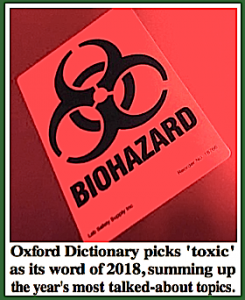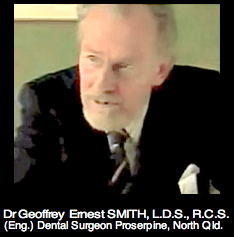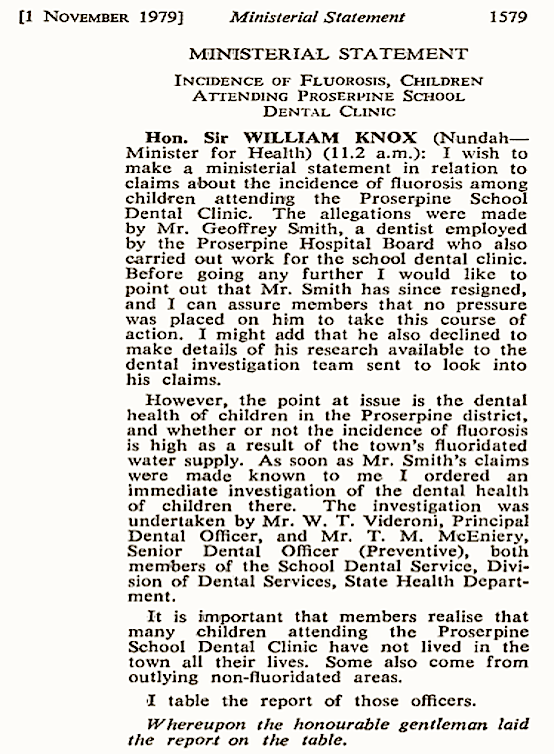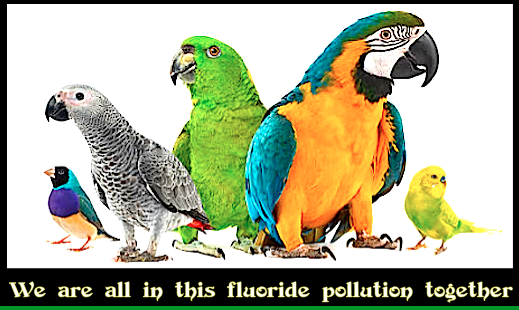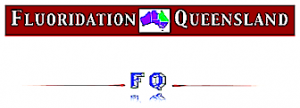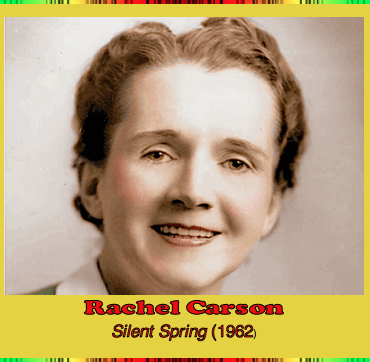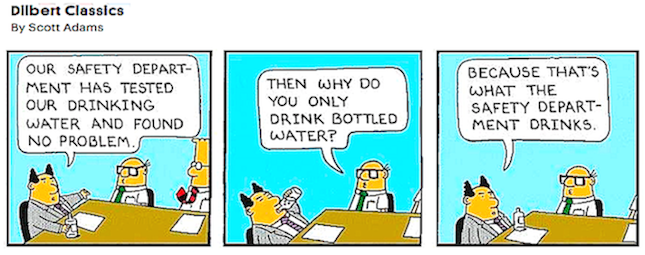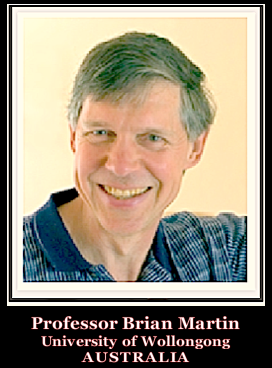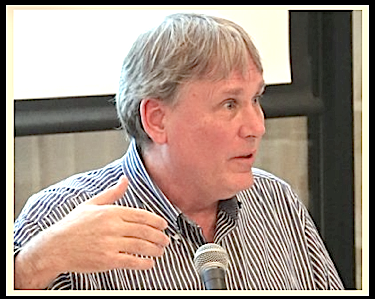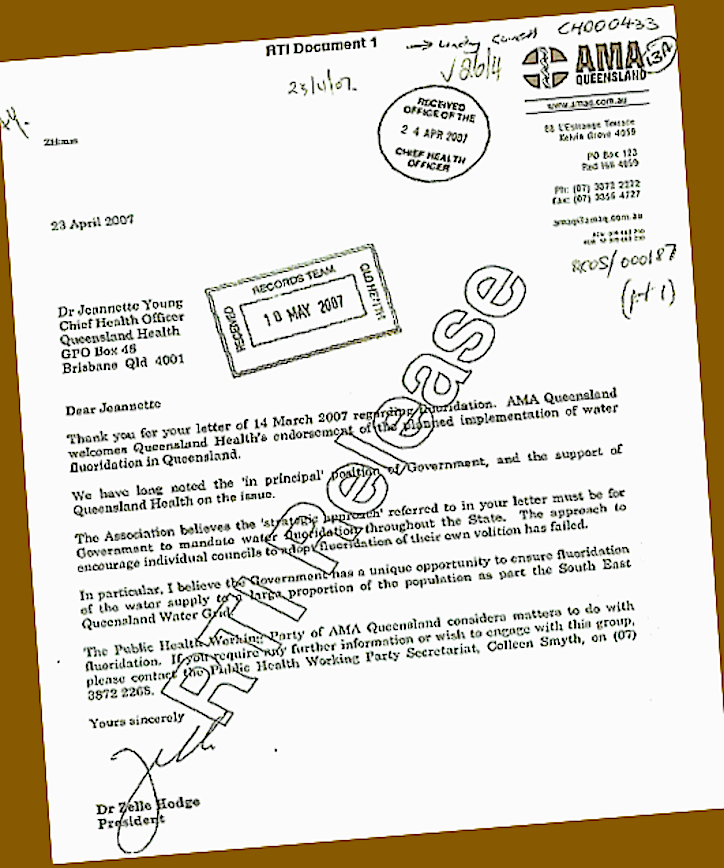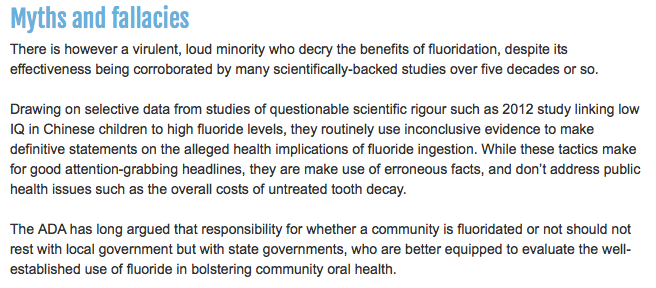As Dr. Frederick Exner noted: “If American Industry had to stop
polluting our air, water, and our countryside with fluoride
fumes and fall-out, and to dispose of its fluoride
wastes without creating a public hazard,
it would cost, not mere millions, but
countless billions of dollars.

— FOLLOW THE MONEY —



We must also consider the concept of a control group
in establishing cause and effect.
Without a control group, the effect of fluoride gases are confused with the effect of
fluoridated water or toothpaste. This camouflage has served
the interests of powerful corporations since 1945.
Fluorine constitutes 0.065 per cent of the elements of the
earth’s crust and is a significant component of the total
biogeochemical cycle in which life has evolved. Mankind has
always been exposed to fluoride in the environment; and
fluoride has always been a trace constituent of our diet and
a component of our body fluids, tissues and skeleton.
Indeed, the ubiquitous occurrence of fluoride in nature
means that it would be virtually impossible to prepare a
diet entirely free of fluoride.
But, until the start of the industrial revolution, most of
the fluoride in the environment was safely ‘locked-up’ in
rocks, coal and clays, and only relatively small amounts
were released either as a result of volcanic activity (HF
can be detected in volcanic gases), coal burning, or the
slow leaching of fluoride into some waters.

Over the past 50 years, a variety of industries have
released into the atmosphere more than
25,000,000 tons of fluoride gases and particulates.
Dentists will argue, correctly, that mankind has always been
exposed to fluoride in the environment. We have also been|
exposed to trace amounts of arsenic, lead, cadmium, and
background radiation. The human body can handle certain
levels of potentially harmful substances, there’s no doubt
about that. But, remember, there are ‘threshold levels’
above which the poison begins to harm the body or the way it
functions. Since each one of us is metabolically unique,
some people are more sensitive to fluoride than others.
Today, a significant proportion of the fluoride that enters
the human body is from modern man-made sources, and all the
indications are that you and your family are now being over-
exposed to what scientists in the Manhattan Project named –
‘The Devil’s Element’.
You will have heard of fluoride. It’s the miracle ingredient
in your toothpaste, and the chemical they put in public
water supplies to prevent cavities in teeth. You may have
heard of hydrogen fluoride. It’s a common, particularly
dangerous but relatively unknown air pollutant
produced by the most powerful industries including:
steel mills, iron foundries, copper, zinc and aluminum
smelters, plastics manufacturers, fertilizer works,
agro-chemical factories, petro-chemical refineries,
brick works, glass factories, coal-burning power stations,
and nuclear processing plants. The use of unleaded gasoline
puts more fluoride into the air.
If health authorities were to set air pollution standards
for hydrogen fluoride which were harmless, then certain key
industries in our technologically-oriented society would
almost grind to a halt. This dilemma led to the most bizarre
conspiracy of modern times in which captains of industry
and national security agencies combined to ruthlessly
suppress evidence of the dangers of hydrogen fluoride air
pollution; and, cynically used a healing profession –
dentistry – to promote an apparently beneficial image for fluoride.
The result is that we live in an increasingly ‘fluoridated’
world. The fluoride in water and toothpaste is potentially
harmful; the hydrogen fluoride in contaminated air far more
so. Each year, tens of thousands of tons of hydrogen
fluoride create an environmental hazard more threatening
than global warming or depletion of the ozone layer; and
hydrogen fluoride, which can be 1,000 times more harmful
than sulphur dioxide, is often a key, but rarely mentioned
component of ‘acid rain’.
Few people living in the developed countries of the world
can escape exposure to hydrogen fluoride (HF). Workers in
more than 60 occupations are now breathing HF-contaminated
air, and anyone living in the vicinity of the fluoride-
polluting industries is also at risk.
The World Health Organization has estimated that many
millions of people live in areas with air pollution problems
severe enough to cause tens of thousands of premature deaths
each year and leave many more chronically ill and disabled.
During this century three major air pollution disasters
emphasized the link between contaminated air, disaster and
death. These occurred in the Meuse Valley, Belgium, in 1930;
Donora, Pennsylvania in 1948, and London in 1952. The worst
began in London on Thursday, 4th December, and lasted three
days. During this period, 4,000 people in London died from
heart and lung disease.
Hydrogen fluoride was the chief killer in all three disasters.
At incredibly low concentrations HF can induce subtle
changes in enzyme activities, nerve action potentials and
host defence – the immune system.
Hydrogen fluoride at a concentration of just 0.1 parts per
billion in air can damage sensitive vegetation; at a
concentration of 1 part per billion it can devastate
vineyards and orchards. Of all air pollutants which affect
farm animals, hydrogen fluoride has caused the most severe
and widespread damage. Yet health authorities insist that
low-level long-term exposure to HF cannot harm human health!
If there is scientifically acceptable evidence to support
these claims about the hazards of HF, how on earth have
authorities managed to deceive people for so long? Why do we
hear so much about sulphur dioxide, nitrogen oxides and
carbon monoxide, and so little about hydrogen fluoride?
Because most people have been ‘brain-washed’ into believing
that ‘fluoride’ is good for them. After all, it’s put into
water and toothpaste to prevent tooth decay. If you can
drink water containing 1 part per million fluoride, and use
toothpaste containing 1,000 parts per million fluoride, then
how could fluoride in air at a level of parts per billion be
harmful?
In other words, health authorities pretend that fluoride in
the air is the same as fluoride in drinking water and
toothpaste. They even present their measurements of hydrogen
fluoride in air as – fluoride. When describing water
fluoridation, the same tactic is used … sodium fluoride
and fluosilicic acid are described as “natural,” avoiding
the fact that in areas with “natural” fluoridation, the
compounds involved are not these toxic wastes of industry,
but a much less toxic compound of fluoride and calcium.
In the 1930’s scientists in Britain, Europe and the United
States knew that low levels of HF were harmful. Furthermore,
they had identified a visible symptom of chronic HF
poisoning.
Children who grew up near industries with fluoride-pollution
problems could develop ‘mottled’ teeth; so too could cattle
and sheep in the vicinity. The relationship between HF air
pollution and ‘mottled’ teeth was an obvious threat to the
Captains of Industry. They might argue whether it was
sulphur dioxide, nitrogen oxides or hydrogen fluoride that
was responsible for damage to crops and livestock, but no
other air pollutants caused mottled teeth.
In 1930 there were plenty of ‘mottled’ teeth amongst
children in Pittsburgh, Pennsylvania, headquarters of the
Aluminium Company of America, Alcoa. The head chemist of
Alcoa, H.V. Churchill, was given the job of ‘explaining’ the
‘mottled’ teeth in a way that would deflect attention away
from Alcoa’s fluoride air pollution problems.
Tooth decay is caused by bacteria – single-celled organisms,
which, like all cells – both enamel and vegetable – are
extremely sensitive to fluoride which, above certain
concentrations, is a potent poison.
The most common bacterium implicated in the
cause of caries is Streptococcus mutans. Levels of fluoride
above 20 partsper million are lethal to S. mutans;
levels as low as 0.19ppm fluoride can interfere with certain
essential metabolic enzymes in the bacterium; and
concentrations of fluoride between 4 and 20 ppm can
cause S. mutans to – mutate. In other words, fluoride
is an anti-microbial agent of great potency.
The development of a cavity in a tooth proceeds in the
following manner. S. mutans (or other cariogenic bacteria)
must first gain attachment to the tooth surface. Once
attached, and given a suitable food supply, the bacteria
thrive and multiply, producing colonies known as dental
plaque. Within the plaque, millions of microbes are consuming
carbohydrates and excreting dilute acids as waste products.
These acids begin to eat away – demineralize – the surface layers
of the tooth enamel. As a result, the enamel is broken down
into its component parts, which include,calcium, phosphate,
carbonate and trace amounts of fluoride
(which was incorporated into the enamel as it developed).
Gradually, the fluoride level in the plaque fluid builds up.
When it reaches 0.19 ppm the metabolism of the bacteria
slows down – less food is consumed and fewer acid wastes
produced. As the level rises above 4 ppm fluoride, the
‘mutation rate’ of the bacteria increases dramatically.
Finally, as the fluoride concentrations in the plaque rises
to lethal levels, the bacteria die. And, there may even be
some re-mineralization of the enamel.
Wonderful! A cavity has been prevented! But all this has
taken place on the surface of the [tooth] body, not inside it.
Of course fluoride is not the only element that can prevent
decay topically. Any potentially toxic element which can
become incorporated in tooth enamel, such as the bone-
seeking elements – radium, uranium, cadmium, lead and
strontium-90, will kill cariogenic bacteria as they are
released from enamel as a consequence of the de-mineralizing
effect of the microbes’ acid wastes.
Trace amounts of fluoride are present in bone mineral –
which is very similar to the mineral in tooth enamel.
However, there is a crucial difference between bone and
enamel. Once fully formed, tooth enamel is static – it
doesn’t undergo metabolic changes. Bone, on the other hand,
is constantly being remodelled. This involves ‘old’ bone
being resorbed and ‘new’ bone laid down. Cells called
osteocytes and osteoclasts dissolve the ‘old’ bone and
osteoblasts help form ‘new’ bone.
All bone contains some fluoride, and as old bone is
dissolved it is released into the vicinity of the resorbing
cells, and evolution has ensured that the bone cells can
withstand very low levels of fluoride.
But, just as the cariogenic bacteria can be harmed by the
excessive levels of fluoride, so too can bone cells and bone
marrow cells – which include the progenitors of immune
system cells.
The events described above explain the symptoms associated
with both dental and skeletal fluorosis; unfortunately they
also raise the spectre of bone cancer and leukemia.
As Dr. Frederick Exner noted: “If American Industry had to
stop polluting our air, water, and our countryside with
fluoride fumes and fall-out, and to dispose of its fluoride
wastes without creating a public hazard, it would cost, not
mere millions, but countless billions of dollars. and
therein lies the explanation for the utterly relentless
drive to fluoridate our water supplies by any means, fair or
foul, and many other puzzling aspects of the drive to
fluoridate.”
Because of the dental profession’s infatuation with fluoride,
tens of millions of people around the world have ‘mottled’
teeth caused by fluoridated drinking water, fluoridated dental
health products, or fluoride air pollution. The evidence is inescapable.
Although cosmetic dentistry can cover up the visible damage
to teeth, it is costly and highly profitable for dentists.
The dental profession’s longtime promotion of fluoride has
created a need for cosmetic dentistry – yet for years,
dentists argued that by pushing fluoride they would be
putting themselves out of business!
Well, guess what … the litigation has now begun.
And once a jury accepts that fluoride can harm developing
teeth, the next obvious question will be: If fluoride can
damage tooth cells, what other cells and tissues in the
human body are being harmed?
The flood-gates will open. Over the next decade it is
conceivable that in North America, Britain and Australia, at
least fifteen million people will be seeking damages for
‘mottled’ teeth – from toothpaste manufacturers, dentists,
and local authorities who permitted fluoridation. A lot of
money will be involved; even at $10,000 per person, a pretty
modest sum these days, we are talking about $150 BILLION.
Are you beginning to get the picture? The dental profession,
federal and state health authorities, and certain important
industries, CANNOT admit, after 50 years, that fluoride has
been damaging human health; the consequences are
unthinkable.
REFERENCES:
Smith G.E., The Secret War and the Fluoride Conspiracy,
Epeius Publishing Associates, 2 Edna Street, Frankston,
Victoria, Australia 3199, 1997.
Diesendorf, M., et. al., New evidence on fluoridation,
Australian and New Zealand Journal of Public Health,
21(2):187-190, May 1997.
Colgate pays out for teeth ruined by fluoride, by Linda
Jackson, The Sunday Telegraph, November 24, 1996.
China takes a deep breath, U.S. News & World Report,
September 9, 1996, page 36.
Health Effects of Ingested Fluoride, Subcommittee on Health
Effects of Ingested Fluoride, Committee on Toxicology, Board
on Environmental Studies and Toxicology, Commission on Life
Sciences, National Research Council, August 1993.
Toxicological Profile for Fluorides, Hydrogen Fluoride, and
Fluorine (F), (April 1993), U.S. Dept. Health and Human
Services, Agency for Toxic Substances and Disease Registry.
Review of Fluoride Benefits and Risks, Department of Health
and Human Services, February 1991.
Stannard, et al, Fluoride levels and fluoride contamination
of fruit juices, Journal of Clinical Pediatric Dentistry, v
16(1) 1991.
Susheela, A.K., Fluorosis — Early Warning Signs and
Diagnostic Test, Bulletin of the Nutrition Foundation of
India, 10:2, April 1989.
Fluoridation of Water, Special report by Bette Hileman,
Chemical & Engineering News-August 1, 1988.
Smith G.E., Fluoride and Fluoridation. Soc.Sci.Med., 26,
(4), 451-462, 1988.
Trace Elements in Human and Animal Nutrition –Fifth
Edition, Edited by Walter Mertz, U.S. Dept. of Agriculture,
Agricultural Research Service, Beltsville Human Nutrition
Research Center, Beltsville, Maryland, 1987.
Zimmerman, Norman, Ph.D., J.D., Senior Toxicologist, Toxic
Substance Control Commission (Michigan), The Need for the
Determination of the Extent of Total Fluoride Exposure in
Community Assessment of the Value of Water Fluoridation, May
1981.
Harold C. Hodge, Ph.D., The Safety of Fluoride Tablets or
Drops, Continuing Evaluation of the Use of Fluorides,
chapter 11, AAAS Symposium, Boulder, CO, Westview Press,
1979.
Curzon & Specter, An Association Between Strontium in
Drinking Water Supplies & Low Caries Prevalence in Man,
Archives of Oral Biology 23:317-321, 1978.
Erickson, J. David, Mortality in Selected Cities With
Fluoridated and Non- Fluoridated Water, New England Journal
of Medicine, May 1978.
Drinking Water and Health, Safe Drinking Water Committee,
National Academy of Sciences, NAS/NRC, 1977.
National Research Council of Canada (NRCC No. 16081),
Associate Committee On Scientific Criteria for Environmental
Quality, Environmental Fluoride 1977.
Prival and Fisher, Adding Fluorides To The Diet,
Environment, 16:29-33, 1974.
Air Pollutants Affecting The Performance of Domestic
Animals, U.S.D.A. Handbook #380, 1972.
Biologic Effects of Atmospheric Pollutants FLUORIDES,
Committee on Biologic Effects of Atmospheric Pollutants,
Division of Medical Sciences, National Research Council,
National Academy of Sciences, Washington, D.C., 1971.
World Health Organization, International Drinking Water
Standards, 1971.
World Health Organization, Fluorides and Human Health, 1970,
p. 32- 239-240.
Radiological Aspects of A New Type of Bone Fluorosis, ,
Periostitis Deformans, Radiology 87:1089-1094, 1968.
Sievers, Maurice L., Disease Patterns Among Southwestern
Indians, Public Health Reports 81:1082, 1966.
The Fluoride Content of Some Foods and Beverages, Journal of
Food Science 31:941,1966.
Endemic Fluorosis, Medicine 42:229, 1963.
Pathologic Studies in Man After Prolonged Ingestion of
Fluoride in Drinking Water, Public Health Reports 73:721-
723, 1958.
The problem of providing optimum fluoride intake for
prevention of dental caries, Food and nutrition Board,
Division of Biology and Agriculture, National Academy of
Sciences, National Research Council, Pub. #294, November
1953.
Kidney Function & Structure In Chronic Fluorosis, British
Journal Experimental Pathology 33:168, 1952.
Report of the Ad Hoc Committee on the Fluoridation of Water
Supplies, Division of Medical Sciences, National Research
Council, Nov. 29, 1951.
McClure, Frank J., Non Dental Physiological Effects of Trace
Quantities of Fluorine, Journal American College of
Dentists, vol 12, p. 50, 1945.
Linsman, Crawford & McMurray, Fluoride Osteosclerosis from
Drinking Water, (Case report) Radiology, 40:474 May, 1943
(see erratum, June)
Dean, H. Trendley, Endemic Dental Fluorosis or Mottled
Enamel, Journal American Dental Association, 30:1278, 1943.
McClure, Frank J., Ingestion of fluoride and dental caries –
-quantitative relations based on food and water requirements
of children 1 to 12 years old, American Journal Diseases of
Children, 66:362, 1943.
Fluorides in Food and Drinking Water, National Institutes of
Health Bulletin, 1939.
Removing Stains From Mottled Enamel, Journal American Dental
Association,1937.
Roholm, Kaj, Fluorine Intoxication: A Clinical-Hygienic
Study With a Review of the Literature and Some Experimental
Investigations, 1935, Translated by W.E. Calvert., published
by H.K. Lewis & Co., Ltd., (London) 1937.
Dean, H. Trendley, Some Epidemiological Aspects of Chronic
Endemic Dental Fluorosis, American Journal of Public Health,
26:567, 1936
“It is difficult to get a man to understand something
when his salary depends on his not understanding it”
– Upton Sinclair –
See also on this web site: ↓
❝ A handful of dentists in the various States have advised Health Ministers that fluoridation is universally safe. But dentists’ expertise is limited to areas of the mouth, specifically the teeth and gums; they know nothing of what can happen to fluoride in other parts of the body, and most of them couldn’t care less…
Anyone who looks at the original evidence would be appalled, because it is shoddy, superficial and inadequate. However, dentists have said fluoridation is safe and they can’t go back on that; too many of them would be left with egg on their faces. Additionally, there is the growing fear of litigation… Politicians don’t like having to repeal laws they themselves introduced; and Professors of Dentistry don’t fancy losing their reputations!” Dr. Geoffrey E. Smith. 1983
About Dr. Smith
Dr Geoffrey Ernest Smith, L.D.S., R.C.S. (Eng.)
Dental Surgeon, (retired)
Curriculum Vitae:
1 Born: 1 November 1932, Married, 5 children, 4 grandchildren.
2 Educated: Lawrence House School, St. Annes on Sea, Lancashire.
Rossall School, Fleetwood, Lancashire. University of Manchester,
Turner Dental School.
3 1956: Qualified L.D.S., R.C.S. Royal College of Surgeons. (England).
4 1957-59 Post-Graduate Studies. Queens University, Belfast.
5 1959-60 Travelling Fellowship, UK Medical Research Council;
WHO Regional Office, Brazzaville. Based University of Ibaden W. Nigeria.
Field work: Nigeria, Ghana, Sierra Leone, Gambia and Liberia.
6 1961-68 General Dental Practice, London and Dublin.
7 1965-66 Consultant, Aspro-Nicholas, Ireland, Ltd., Dublin.
8 1969-71 Consultant, Glaxo Group Ltd., London.
9 1972-74 Consultant, PIA Ltd., Lopex Group, London, New York.
10 1974-76 Consultant, Nicholas International, Slough & Melbourne.
11 1976-79 General Dental Practice and School Dentistry, Melbourne.
12 1979-80 Hospital Dentist, Proserpine, North Queensland.
13 1987-88 Anthropology and Archaeology, University of Melbourne.
14 1980 – Consultant, Environmental and Public Health.
SOME RELEVANT PAPERS IN THE SCIENTIFIC LITERATURE
1 NZ Med.J. 1983;96, 1067-1068.
2 Persp. Biol.Med. 1986 29, 560-
3 New Scientist 1983;5 May 286-287
4 Trends.Pharm.Sci.1986, 7, 10
5 Fluoride, 1983, Editorial, Autumn.
6 Sci.Tot.Environ. 1987, 63, 1-11.
7 Aust.Dent.J. 1984, 29, 199-200.
8 Endeavour, 1987, 11, 16-
9 J.R.Coll Gen.Pract.1984, 34, 350-351.
10 Sci.Prog.(Oxf.), 1987, 71, 23
11 Xenobiotica, 1985, 15, 177-186.
12 The Scientist, 1987, 1, 24.
13 Sci.Prog.(Oxf.), 1985, 69, 429-442.
14 Sci.Tot.Env., 1988, 68, 79-86.
15 Sci.Tot.Env. 1985, 43, 41-61.
16 NZ Med.J. 1985, 90, 556-557.
17 NZ Med.J. 1985, 98, 454-455.
18 Pers.Biol.Med. 1988, 31, 440-45
19 NZ Med.J. 1988, 100, 669-670.
20 Sci.Tot.Env., 1988, 76, 167-
21 New Scientist, 1985, 1467-, 50-51.
22 NZ Med.J. 1988, 101, 802.
23 NZ Med.l. 1985, 30, 232-233.
24 Med.Hypoth., 1986, 19, 139-
25 Med.J.Aust., 1985, 143, 283-286.
26 Mutat.Res., 1990, 241, 339-
27 Med.J.Aust., 1986, 144, 152.
28 Fusso Kenkyo, 1990, 11, 38-48
29 Lawyer, 1986, 4(3), 6. (Japanese)
30 Fluoride, 1986, 19, 105-107.
31 Probe, 1989, 31, 1-2.
32 Nature 1986; 323, 198.
22 NZ Med.J. 1988, 101, 802.
23 NZ Med.l. 1985, 30, 232-233.
24 Med.Hypoth., 1986, 19, 139-
25 Med.J.Aust., 1985, 143, 283-286.
26 Mutat.Res., 1990, 241, 339-
27 Med.J.Aust., 1986, 144, 152.
28 Fusso Kenkyo, 1990, 11, 38-48
29 Lawyer, 1986, 4(3), 6. (Japanese)
30 Fluoride, 1986, 19, 105-107.
31 Probe, 1989, 31, 1-2.
32 Nature 1986; 323, 198.
33 Aust. Dent.J., 1985, 30, 232-233

The Control of Dental Caries:
Can Vaccines Prevent Cavities?
G. E. Smith
Abstract:
Essentially, responsibility for developing and implementing measures designed to control dental caries should rest with the dental profession. Many of the most effective ways of controlling caries, however, involve the use of fluoride. Either systemically via fluoridated water and tablets or, topically, with fluoride-containing toothpaste and mouthrinses. Scientists in many disciplines are aware that fluorides can, in certain circumstances, endanger the environment. There is some evidence that fluoride contamination of the total environment has increased in recent years. The usefulness of fluoride as a caries preventive does not mean that unnecessary exposure to the element should be tolerated. It is conceivable that fluoride is approaching the limits of its effectiveness as a caries preventive. With this possibility in mind, recent research directed toward the development of safe, effective anti-tooth decay vaccines has been reviewed.
‘The Secret War’ was originally prepared as a personal submission to
He made two submissions
— A Short Good Read —
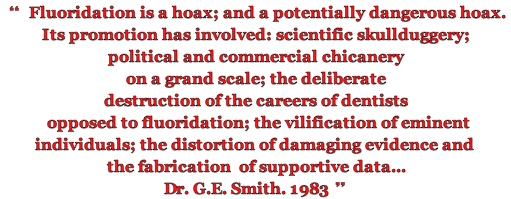
❝ A handful of dentists in the various States have advised Health Ministers that fluoridation is universally safe. But dentists’ expertise is limited to areas of the mouth, specifically the teeth and gums; they know nothing of what can happen to fluoride in other parts of the body, and most of them couldn’t care less…
Anyone who looks at the original evidence would be appalled, because it is shoddy, superficial and inadequate. However, dentists have said fluoridation is safe and they can’t go back on that; too many of them would be left with egg on their faces. Additionally, there is the growing fear of litigation… Politicians don’t like having to repeal laws they themselves introduced; and Professors of Dentistry don’t fancy losing their reputations!” Dr. Geoffrey E. Smith. 1983
About Dr. Smith
Dr Geoffrey Ernest Smith, L.D.S., R.C.S. (Eng.)
Dental Surgeon, (retired)
Curriculum Vitae:
1 Born: 1 November 1932, Married, 5 children, 4 grandchildren.
2 Educated: Lawrence House School, St. Annes on Sea, Lancashire.
Rossall School, Fleetwood, Lancashire. University of Manchester,
Turner Dental School.
3 1956: Qualified L.D.S., R.C.S. Royal College of Surgeons. (England).
4 1957-59 Post-Graduate Studies. Queens University, Belfast.
5 1959-60 Travelling Fellowship, UK Medical Research Council;
WHO Regional Office, Brazzaville. Based University of Ibaden W. Nigeria.
Field work: Nigeria, Ghana, Sierra Leone, Gambia and Liberia.
6 1961-68 General Dental Practice, London and Dublin.
7 1965-66 Consultant, Aspro-Nicholas, Ireland, Ltd., Dublin.
8 1969-71 Consultant, Glaxo Group Ltd., London.
9 1972-74 Consultant, PIA Ltd., Lopex Group, London, New York.
10 1974-76 Consultant, Nicholas International, Slough & Melbourne.
11 1976-79 General Dental Practice and School Dentistry, Melbourne.
12 1979-80 Hospital Dentist, Proserpine, North Queensland.
13 1987-88 Anthropology and Archaeology, University of Melbourne.
14 1980 – Consultant, Environmental and Public Health.
SOME RELEVANT PAPERS IN THE SCIENTIFIC LITERATURE
1 NZ Med.J. 1983;96, 1067-1068.
2 Persp. Biol.Med. 1986 29, 560-
3 New Scientist 1983;5 May 286-287
4 Trends.Pharm.Sci.1986, 7, 10
5 Fluoride, 1983, Editorial, Autumn.
6 Sci.Tot.Environ. 1987, 63, 1-11.
7 Aust.Dent.J. 1984, 29, 199-200.
8 Endeavour, 1987, 11, 16-
9 J.R.Coll Gen.Pract.1984, 34, 350-351.
10 Sci.Prog.(Oxf.), 1987, 71, 23
11 Xenobiotica, 1985, 15, 177-186.
12 The Scientist, 1987, 1, 24.
13 Sci.Prog.(Oxf.), 1985, 69, 429-442.
14 Sci.Tot.Env., 1988, 68, 79-86.
15 Sci.Tot.Env. 1985, 43, 41-61.
16 NZ Med.J. 1985, 90, 556-557.
17 NZ Med.J. 1985, 98, 454-455.
18 Pers.Biol.Med. 1988, 31, 440-45
19 NZ Med.J. 1988, 100, 669-670.
20 Sci.Tot.Env., 1988, 76, 167-
21 New Scientist, 1985, 1467-, 50-51.
22 NZ Med.J. 1988, 101, 802.
23 NZ Med.l. 1985, 30, 232-233.
24 Med.Hypoth., 1986, 19, 139-
25 Med.J.Aust., 1985, 143, 283-286.
26 Mutat.Res., 1990, 241, 339-
27 Med.J.Aust., 1986, 144, 152.
28 Fusso Kenkyo, 1990, 11, 38-48
29 Lawyer, 1986, 4(3), 6. (Japanese)
30 Fluoride, 1986, 19, 105-107.
31 Probe, 1989, 31, 1-2.
32 Nature 1986; 323, 198.
22 NZ Med.J. 1988, 101, 802.
23 NZ Med.l. 1985, 30, 232-233.
24 Med.Hypoth., 1986, 19, 139-
25 Med.J.Aust., 1985, 143, 283-286.
26 Mutat.Res., 1990, 241, 339-
27 Med.J.Aust., 1986, 144, 152.
28 Fusso Kenkyo, 1990, 11, 38-48
29 Lawyer, 1986, 4(3), 6. (Japanese)
30 Fluoride, 1986, 19, 105-107.
31 Probe, 1989, 31, 1-2.
32 Nature 1986; 323, 198.
33 Aust. Dent.J., 1985, 30, 232-233
Extract from
THE CONTROL OF DENTAL CARIES:
CAN VACCINES PREVENT CAVITIES?
by G.E. SMITH
Abstract:
Essentially, responsibility for developing and implementing measures designed to control dental caries should rest with the dental profession. Many of the most effective ways of controlling caries, however, involve the use of fluoride. Either systemically via fluoridated water and tablets or, topically, with fluoride-containing toothpaste and mouth rinses. Scientists in many disciplines are aware that fluorides can, in certain circumstances, endanger the environment. There is some evidence that fluoride contamination of the total environment has increased in recent years. The usefulness of fluoride as a caries preventive does not mean that unnecessary exposure to the element should be tolerated. It is conceivable that fluoride is approaching the limits of its effectiveness as a caries preventive. With this possibility in mind, recent research directed toward the development of safe, effective anti-tooth decay vaccines has been reviewed.
The Secret War’ was originally prepared as a personal submission to
He made two submissions.





